The post Our Favorite Tiled Bars appeared first on The Tile Shop Blog.
]]>This coffee-to-cocktail bar from the 2019 Fall One Room Challenge™ is a sight to behold! Nicole from Nicole White Designs opted for a bold, art deco tile and it paid off in a big, statement-making way.


This classic, simple bar can be dressed up or down for whatever purpose you want it to serve.

This welcoming rustic bar is the perfect place for a hot cup of coffee.

A crisp white backsplash is the perfect contrast to bold cabinetry.

A mirrored bar ups the glamour factor—perfect for entertaining and hosting!

A tiled bar is the perfect place to take a risk. Adding bold hues or patterns is one easy way to make your bar stand out. It’s meant to be a fun spot, right?

Shiplap walls, sea-green cabinets and a mosaic in a mix of soft neutrals combine to form a relaxed, beachy bar.

Want to achieve glamour without going too bold or dramatic? This gold mosaic adds just the perfect amount of glitter to make it special.

This Annie Selke tile featuring flecks of metallic gold create a soothing visual break from dark shelves and cabinets.

What to do with this in-between-rooms nook? Make it into a functional and beautiful bar, of course!

Reclaimed wood tiles are the perfect backdrop to this natural wood bar in a cozy basement.

On that note, we’re feeling a little thirsty. Don’t forget to share your Tile Shop tiled bar on our social media channels with #thetileshop. Ready to start your own project? Get started with a remote design consultation today!
The post Our Favorite Tiled Bars appeared first on The Tile Shop Blog.
]]>The post 2020 Tile Trend: 3D Sculptural appeared first on The Tile Shop Blog.
]]>Lots of 3D tiles incorporate geometric designs. By mixing and matching the different faces of the Tangram series, you can create an entirely unique patchwork look.

Sweeping movements make for a soft, serene landscape, perfect for relaxing in the bath after a long day.

Flora and fauna-inspired motifs bring a natural quality to 3D tiles. We love how this leaf design comes to dramatic life on a black accent wall.

A straight-stack pattern modernizes this matte sculptural tile.

A marble look brings a wink of tradition to this otherwise of-the-moment 3D subway tile.

Ready for a bold statement?! Just add color! Blue is a serene color that is well-loved in home design.

If you’re looking for a subtle way to add interest to your space, opt for a beautiful-yet-simple 3D tile, like the Charm Diamond.

The neutral hues of the Akros Elis Iris create a distinctive, one-of-a-kind shower while still creating that calming, at-home spa experience.

Get the look of an intricate mosaic with fewer grout lines when you utilize a large-format tile like this one.

Complete a bold sculptural look with coordinating trims, accents and finishing pieces. Learn how to layer your look with trim pieces and profiles here.

What do you get when you combine geometric, metallic and sculptural effects into one tile? A stunning statement wall that’s sure to wow.

Is there any tile more perfect for an eye-catching cocktail bar?

A natural stone mosaic blurs the lines between traditional and contemporary.

Ready to find a 3D tile that speaks to you? Schedule a design consultation today!
The post 2020 Tile Trend: 3D Sculptural appeared first on The Tile Shop Blog.
]]>The post Guide to Tile Finishes appeared first on The Tile Shop Blog.
]]>Types of finishes
Finishes, or different effects on the surface of a tile that alter its appearance, are generally divided into ceramic, porcelain and other man-made tiles vs. stone categories because of the different ways the materials can be treated. First, we’ll explore the processes that define stone finishes and then look at man-made tiles.
Stone
Stone tile with a polished finish has been passed under a series of polishing wheels with increasingly finer pads using water and polishing compound to assist in the process. This results in a smooth and shiny tile, perfect for adding a touch of luxury and glamour to formal and traditional spaces. Marble is a one type of stone that is often polished.


Satin finishes are produced through the same process as polished but using fewer polishing wheels. This lends a softer and less shiny appearance to the tile, the perfect balance between polished and honed.

Honed tiles go through the same process as polished and satin but with even fewer wheels that result in a smooth matte finish. This is the most casual finish of the three, reflecting very little light and contemporizing a design.


For a brushed finish, stone is run under wheels with metal bristles to achieve an orange peel-like finish. Benefits of a brushed tile are that its texture provides softness, it handles wear and tear and has a relaxed character.
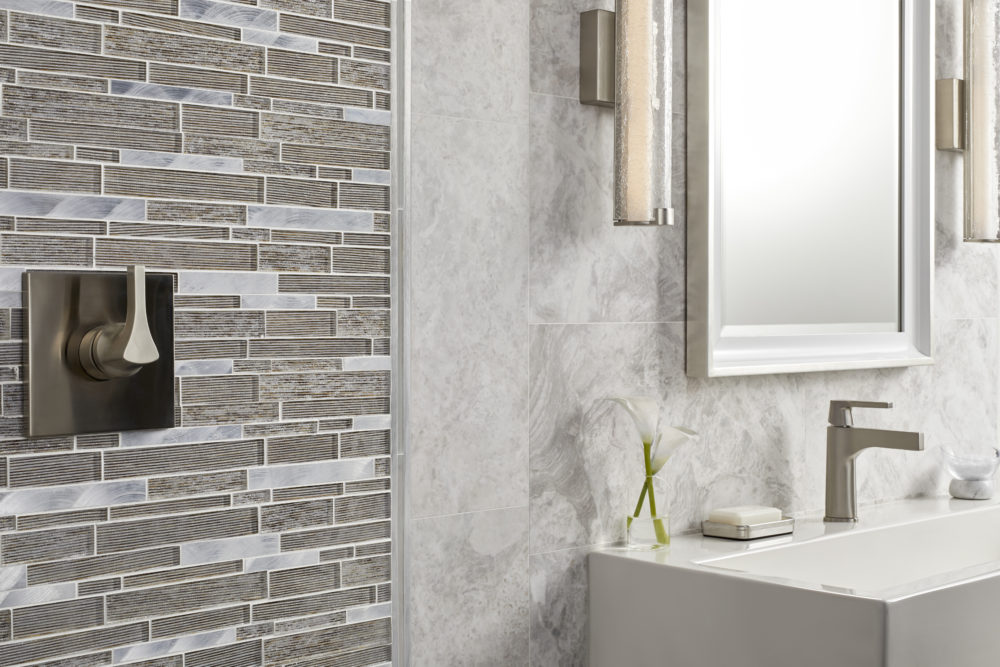
To obtain a tumbled finish, tiles are put into large drums filled with aggregate and shaken. The aggregate wears down the surface of the stone, giving it a rough surface and more rounded edges. Tumbled stones offer increased traction, hide imperfections and flawlessly coordinate with rustic décor.


We’re going au naturel with this one. With natural finish stone tile, what you see is what you get. Nothing is done to the surface of these tiles, and, besides being cut to size, they’re just like they looked when they were quarried. Natural tiles give an authentic and outdoorsy look to your space. Slate is a common example of a natural finish stone.


Filled and unfilled are not exactly finishes, but they alter the surface of a tile so they’re worth mentioning and defining here. Filled stone has its natural crevices and holes filled with an epoxy resin mixed with stone dust in a color that closely resembles the stone’s natural color. This makes the tile easier to clean and install. Unfilled stone is left in its natural state, voids and all. This allows you to choose to fill it with the grout color of your choice or leave it in its rustic, raw state for a unique look.
Here, you can see the difference in appearance of an unfilled travertine compared to a filled travertine. Bucak Silver Honed Unfilled Travertine, on the left, has visible holes and crevices on its surface, whereas Bucak Light Walnut Honed Filled Travertine, on the right, has a lighter colored compound filling in these areas.


Ceramic and Porcelain

Polished tiles are double fired, first with the desired pattern or color and then with a clear coat. Afterwards, they go through the same polishing process as stone, passing under polishing wheels with water and polishing compound. Lastly, the tiles are sealed to retain their appearance. Stone-look porcelain or ceramic tiles are often in polished finishes to mimic the look of natural stone.

A glossy finish is different from polished in that it is created with a glossy glaze instead of a polishing wheel process. Depending on the texture of the tile, gloss glazes can pool in areas, creating thicker and thinner areas of glaze and variations in coloring.

Matte tiles are covered in a non-shiny glaze that is applied with an ink jet machine or in a waterfall stream glazing method. This process yields tiles with a flat finish that do not reflect light and offer a contemporary look.

Multifired tiles are one of the most exciting technological advancements in the industry in recent years. They’re so interesting, we devoted a whole blog post to them! These are tiles that go through more than two firings in a kiln, usually to give them 3-D texture, metallic finish or another interesting effect that is not possible with just one or two firings.

An anti-slip surface is perfect for tiling in wet areas like bathrooms, entryways or mudrooms. They’re also great if aging in place is a consideration in your home. A fine grit or sand is added to a matte glaze to create a rough, gripping texture on the tile.

Textured tile is made by pressing materials into a mold that give a textured effect, such as that of natural stone or wood. Then it’s glazed and fired to achieve the desired look. The below tile is actually a porcelain that has been textured to look like a tumbled stone.

Congratulations! You’ve just completed a crash course in natural stone and man-made tile finishes. If your head is spinning, don’t worry. Our tile experts are waiting in your local store to help you design your next project and choose your perfect tile. Schedule a design consultation or stop in today.
The post Guide to Tile Finishes appeared first on The Tile Shop Blog.
]]>The post Annie Selke’s Barn House in the Berkshires appeared first on The Tile Shop Blog.
]]>
Country Kitchen
Open-concept floor plans are perfect for creating a warm, welcoming environment. By uniting the living room, kitchen and master bedroom, Annie turned this loft into the perfect guest house!


Notice the stone floors? They’re actually all made out of porcelain! Chester Silver Versailles’s stone look and chiseled edges add stunning, visual interest to every room.

To maintain a cozy look, Annie chose Artisanal White for the kitchen backsplash! The handmade look and crackle finish lend the perfect amount of softness and charm. Take a closer look below.

The Metallic Master

The architectural travertine wall tile behind the head of the bed proves that tile can go beyond the kitchen or bathroom. Harmony Silverleaf Mosaic Travertine adds a perfect wow factor with its three-dimensional design and lustrous silver-leaf finish.

Barn House Bath
Travertine stone’s variety of finishes and styles make is so versatile that Annie coordinated it in both the master bedroom and bathroom!

From the ceramic wall tiles to the travertine floor, neutral colors unite in this master bath.
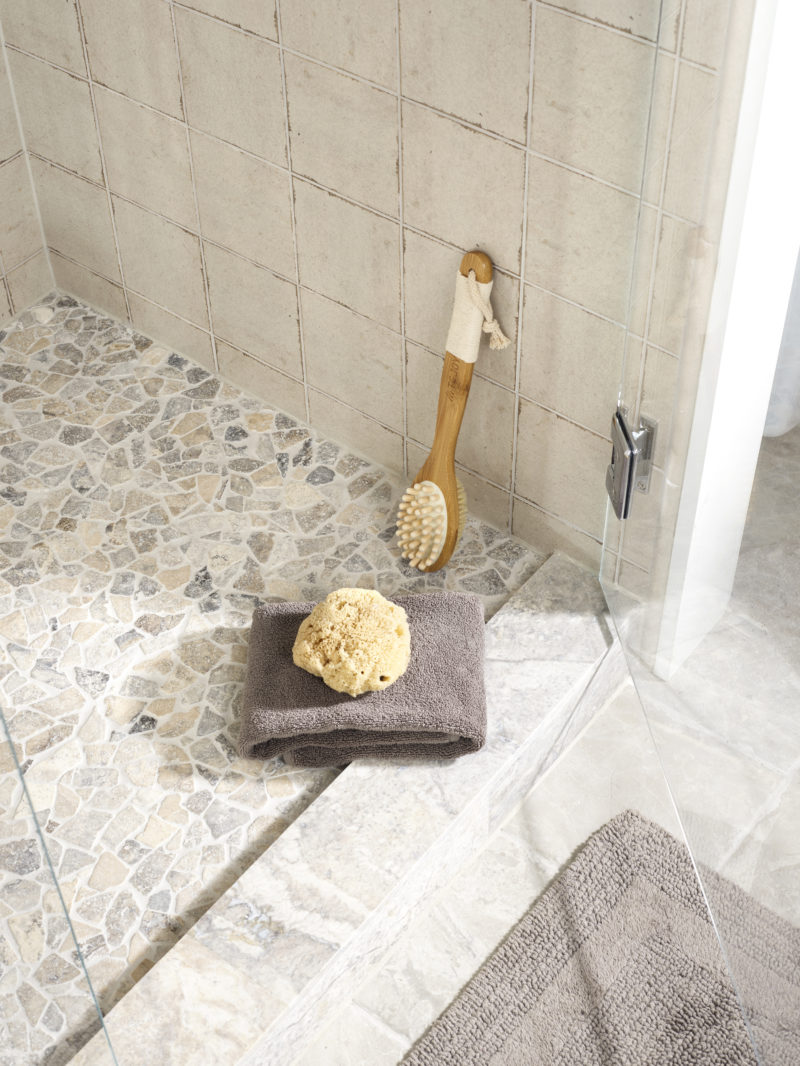
Claros Silver Tumbled Cobble is an excellent option for this shower floor. Its tumbled finish makes it a natural nonslip textured stone!
What is travertine tile? What makes it so versatile? Check out our resource article for everything travertine.

We can’t be the only ones who are a little jealous of the luxurious tub and bathroom, right? Subtle patterned tiles are a great way to make an appealing and timeless statement. The serene, lattice pattern on the wall is so calming to the eye.

It’s time to take a peek inside the kitchen and master bath of Annie’s home!
What’s Cooking in Annie’s Kitchen?

We can’t resist a bright, airy kitchen! Light tints of white, tan and grey create a perfect color palette for a timeless design.
Love the look of stone but want the durability of porcelain? Well, you’re in luck! Annie utilized Cassettone Grey Mosaic’s distinguished, stone look without sacrificing longevity.

Spectacular Speckled Shower

Sure, you’ve seen bold tile looks before, but no statement compares to the design in this shower! Silverleaf Speckle features mirrored silver splatters on top of a cowhide-look texture. This designer tile truly commands and deserves your attention.

Lavish glamour is matched on the bathroom floor with the rows of DURAL Chrome Gloss Square Edge. The metallic trim pieces light the room for an elevated finish.

Craving more Annie Selke? Explore the entire collection.
Ready to start your tile remodel, but you don’t know where to start? We have all the resources you need for your next remodel. Schedule a free design consultation with one of our tile design experts.
The post Annie Selke’s Barn House in the Berkshires appeared first on The Tile Shop Blog.
]]>The post Maximalism: More is More appeared first on The Tile Shop Blog.
]]>White walls, minimal decor, subtle colors—you won’t find any of these in a maximalist space! Some people say that less is more, but maximalists believe the opposite. More color, more texture, and more boldness define this style. Simplistic, neutral design has reigned for years, and, inevitably, some people are ready for a change. Say hello to maximalism.
Contrary to what you might think, maximalism is more than just having a lot of stuff. Some of the hallmarks of maximalist design are:
- Patterns and prints
- Bold colors
- Ornateness
- Layering
- Lots of textures
- Artwork (especially different styles and mismatched frames!)
- Mixing design styles, like boho (it shares a common theme of excess), English, vintage, mid-century modern, Victorian and art deco
- Books, books and more books
The style is an updated twist on classically exuberant English interiors updated for the 21st century with bright colors, contemporary patterns and modern accents. The legendary club Annabel’s in London perfectly embodies this blend of classic Britishness and modern maximalism.
So, what do we love about maximalism? It allows you to express every side of your personality at once. If you’ve ever felt torn between styles or couldn’t define yours in one word, maximalism may be for you. (Indecisive friends, unite!) This design style allows you the freedom to fill your home with items that you love, instead of worrying about fitting them into a style box. Loving your decor is key—random items will not bring the same joy as a personalized, curated collection.
Enough talking about maximalism—let’s see some of our favorite looks! As far as maximalist designs go, this one is pretty minimal! (Stay with us.) The bold, patterned tile and dramatic color scheme definitely fit the style, yet the symmetry of the space and overall glam theme reign in it.

This bathroom takes boho-chic to the next level with a bright geometric tiled floor and lots of fabulous decor pieces. Black accents throughout the room (can we talk about that chandelier?!) bring cohesion to the space without dulling it down. This gorgeous transformation took place in just six weeks as part of the Fall 2019 One Room Challenge™.

We couldn’t just share one photo of the home that sparked the idea for this blog post! House Beautiful’s 2019 Kitchen of the Year was a maximalist dream come true with no explanation needed. Read our spotlight on Michelle Nussbaumer’s amazing design for more photos of the space.



This kitchen is a good reminder that each surface is an opportunity to create a work of art.

A much different approach to maximalism, this bathroom establishes a blue-grey color palette and sticks to it while varying the tone and playing with patterns.

This bright and colorful bathroom proves that maximalism doesn’t have to be dark and dramatic.

Back to the drama, an art-inspired tile is perfect for creating an accent wall that makes a statement.

Multiple patterns work hand in hand when they pull from the same warm color palette in this beautiful bathroom that was also featured in the One Room Challenge.

Maximalist spaces don’t need to hit every hallmark on our list. Here, an oversized, bold pattern is enough to stand out.

Another One Room Challenge contender was this glamorous gold-and-black laundry room. The opulence just draws you in (which is good when you’re trying to force yourself to do the laundry!)

Here’s another case of a stand-alone maximalist tile. The vivacious purple veining in this Milas Lilac marble tile collection and the mix of shapes deliver dynamic style.
Dip your toe into maximalism by just choosing one extra-bold feature.

Drama, patterns, metallic finishes and more—as they say with maximalism, more is more.

Feeling inspired to paint your grey walls fuchsia yet? Whatever your design goals are, we’re here to help you achieve them. Schedule a design consultation with an in-store tile expert to get started. And don’t forget—sometimes more is more!
The post Maximalism: More is More appeared first on The Tile Shop Blog.
]]>The post Our Favorite Fireplace Design Ideas appeared first on The Tile Shop Blog.
]]>
Where to use fireplace tile
Tile can be used on fireplace hearths and surrounds. The hearth, which can be level with the floor or raised above it, is the floor in front of the fireplace. The fire itself is contained to the firebox, and the fireplace surround is the area around the firebox. The surround may go all the way to the ceiling or just around the firebox and may or may not include a mantle. This is the place you are most likely to see tile used. Tile cannot be used inside a wood-burning fireplace, only approved brick and other materials. Altogether, the fireplace is an opportunity to make a statement or define a focal point in the room.

6 styles to consider
One of the hardest parts of tiling is deciding on your perfect style from endless options. We may be guilty of offering too much inspiration, but we’ve rounded up our favorite fireplaces into six themes to help simplify your search.
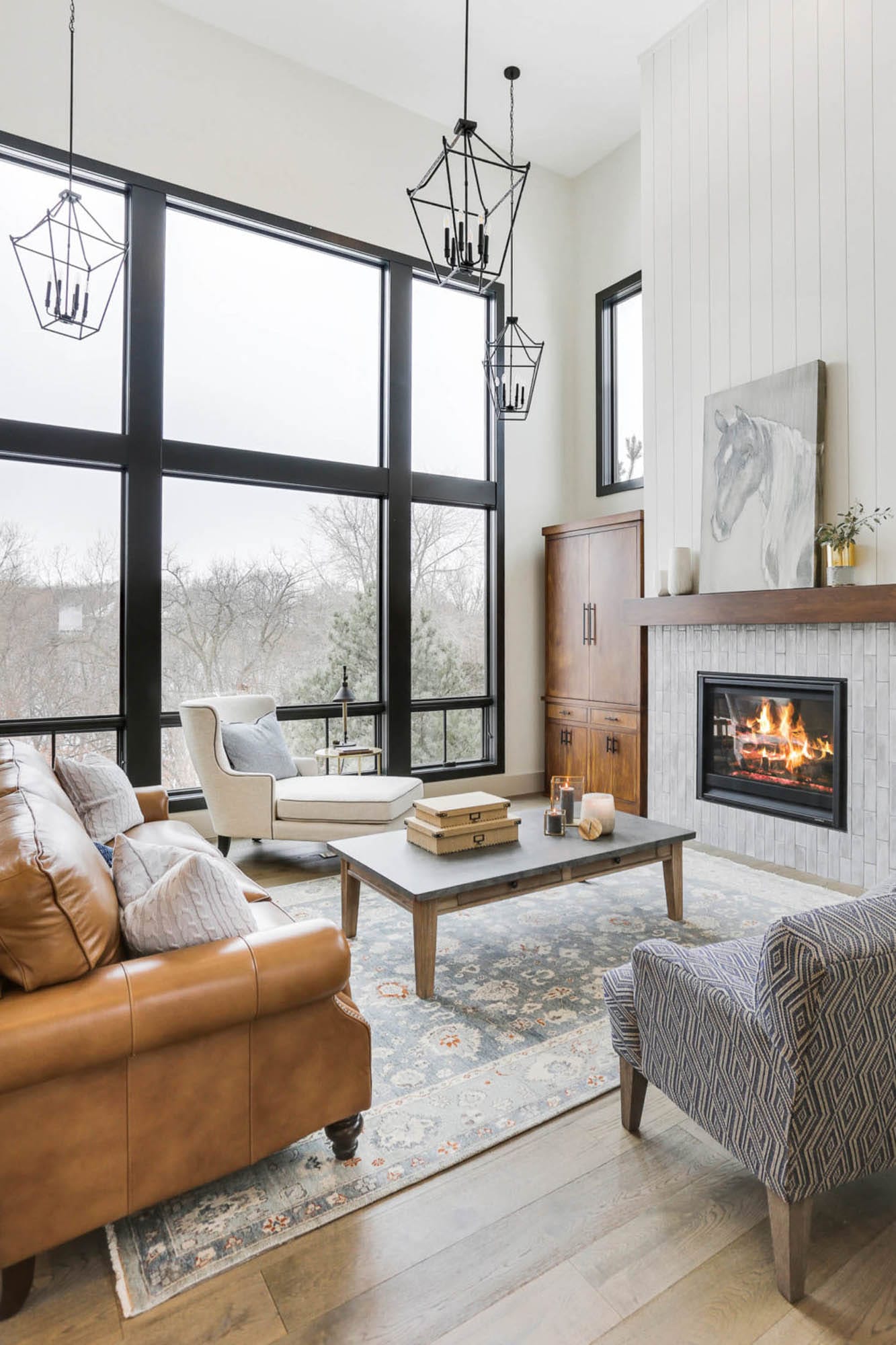

1. Small-Scale Patterns
A tile with a small pattern or a small-scale mosaic is ideal for making a small fireplace into a focal point. Don’t forget to consider the material and finish. Matte tile is casual and soft, glossy tile reflects the light and glass tile glamorizes a space with even more sparkle.
The crisp, white fireplace tile combined with the white walls and molding are a simple and clean backdrop for fun decor pieces to take center stage.

This fireplace stands apart stylishly with white marble subway tile that creates striking contrast against the dark navy walls.

This rustic fireplace serves double duty, not only separating the kitchen from the living space but also serving as a decorative focus in both rooms.

2. Cement & Cement-Look
Whether contemporary, old world, geometric or romantic, cement and cement-look tiles certainly liven up a fireplace. Pick a pattern you love, and enjoy an eye-catching and unique centerpiece.
This transitional fireplace is a delightful combination of traditional cement-look tile and a clean, contemporary mantle that satisfies all tastes.

A lively cement-look tile from the London series sets the modern farmhouse scene in this quaint home.

3. Floor to Ceiling
Impact is the ultimate goal with a floor-to-ceiling tiled fireplace. These jaw-dropping installations speak volumes.
This stunning fireplace is perfect parts rustic, contemporary and chic.

One way to make your fireplace unforgettable is to situate it in an unexpected place. This one gets bonus points for being enjoyed from the tub and the bedroom on the other side of the wall.

File this fireplace under “statement maker.” A soft, neutral grey tile becomes a focal point when it’s installed to the second-floor ceiling of this grand room.

4. 3-D
Taking your fireplace tile to the next dimension delivers a tactile, textural quality. Use a dimensional geometric tile for the ultimate contemporary statement.
A metallic fireplace tile is always a good idea—just imagine how the dimension and texture of this multifired tile shine when the fire is lit.

Elegant and refined, these soft flowing lines create dimension replicating that of calming coastal waves.

5. Trim Firebox
For a smoother transition between your fireplace surround and firebox, use trims and layering pieces to dress up the design and soften the hard edges.
A Somerset trim tile artfully frames this firebox while adding architectural detail.

The addition of trim to this stunning fireplace instantly elevates the whole look.

6. Architectural
Textured, dimensional architectural tiles are not just for rustic designs! For spaces from traditional to contemporary, these natural stones retain a neutral color scheme while adding touchable dimension.
It’s easy to see why our best-selling architectural tile, Claros Silver, is such a hit—classic grey shades and warm tans are universally appealing.

This centerpiece fireplace displays one of the perks of our architectural tile collections. We carry out corner pieces so your design can truly be three dimensional.

Excited to try something new? Visit our fireplace tile ideas page or our fireplace tile Pinterest board for more inspiration or find a store to get started today!
The post Our Favorite Fireplace Design Ideas appeared first on The Tile Shop Blog.
]]>The post Gilded Glamour: How to Tile in Art Deco Style appeared first on The Tile Shop Blog.
]]>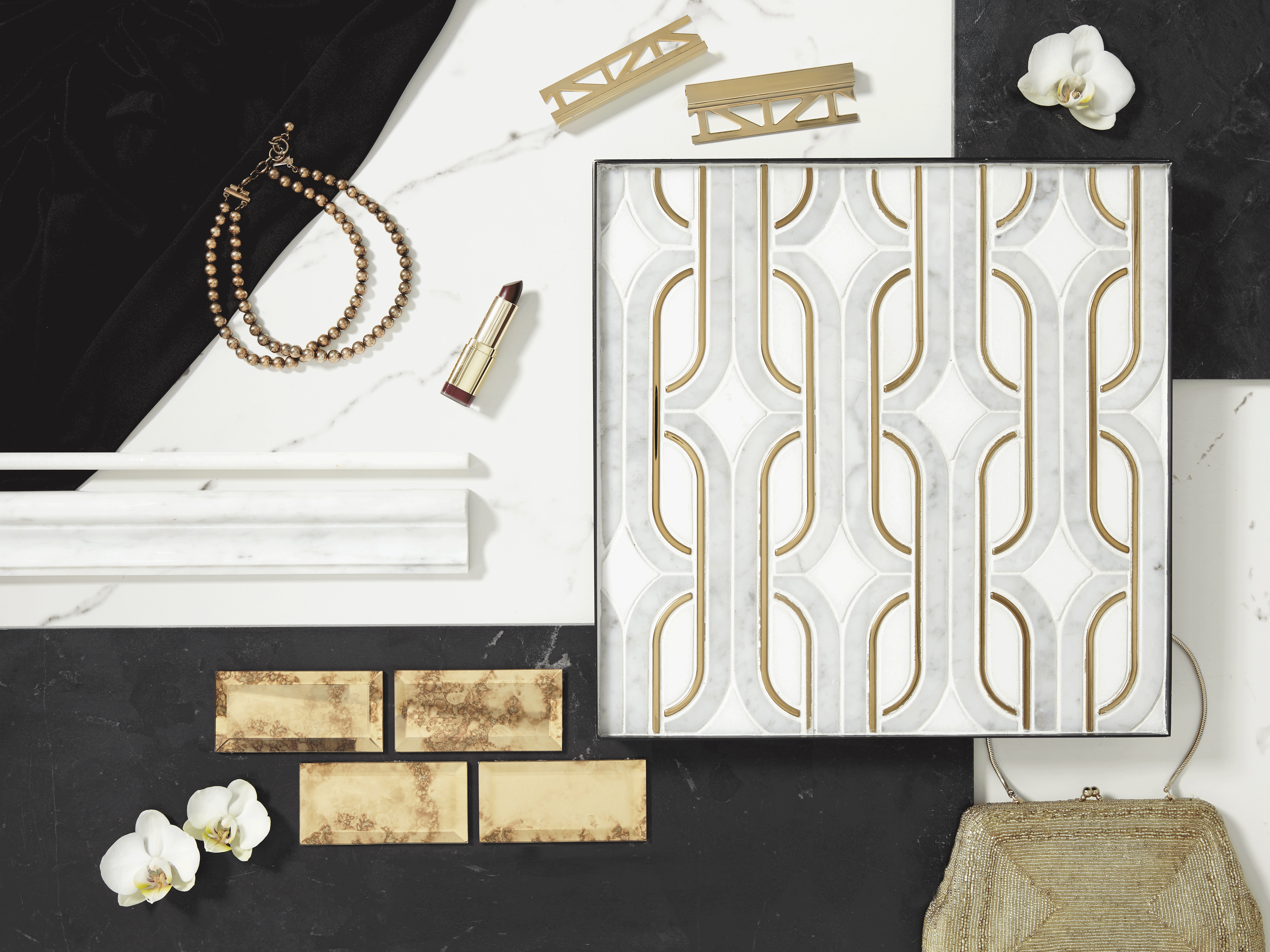
Featured Mosaics: Streamline, Moderne Deco, Skyline
Gilded Glamour, a Tile Shop signature style, blends 1920s art deco design elements with details of modern luxury—and, of course, stunning tile. A gilded touch, which literally means covered in gold, is a hallmark this style is based on. Think the opulence of the Great Gatsby meets the architectural style of the Chrysler Building with a thoroughly current point of view.

Photo by Jonathan Pease on Unsplash
Elements that Define Gilded Glamour
Commonly observed in visual arts, architecture and design, art deco first became popular around World War 1 in France. Then, it was the epitome of luxury, glamour and beautiful craftsmanship. Today, this timeless style still reflects these same aspirational qualities largely defined by five major design elements: geometric shapes, black and white, polished metal, mirrors and shine. Incorporating these elements into a design infuses a space with old-world elegance and allure.
Top Tiles to Get the Gilded Glamour Look
Select tiles from one or more of the below categories, and you will have more than enough inspiration for a Gilded Glamour space of which the Great Gatsby would be envious. Use our recommended products or employ these design elements to create a unique look of your own.
Geometric Shapes
Geometric shapes are defined by simple lines, curves or outlines. The versatility of these interesting shapes makes it easy to customize a look anywhere along the spectrum from subtle to bold. To achieve the Gilded Glamour look, use geometric shapes alongside another art deco design element, like black and white or touches of gold, to highlight the lines. Even with all three art deco design elements in the image below, the overall appearance is elegant and clean. Squares, diamonds, hexagons and any geometric mosaic tiles are a good place to start.
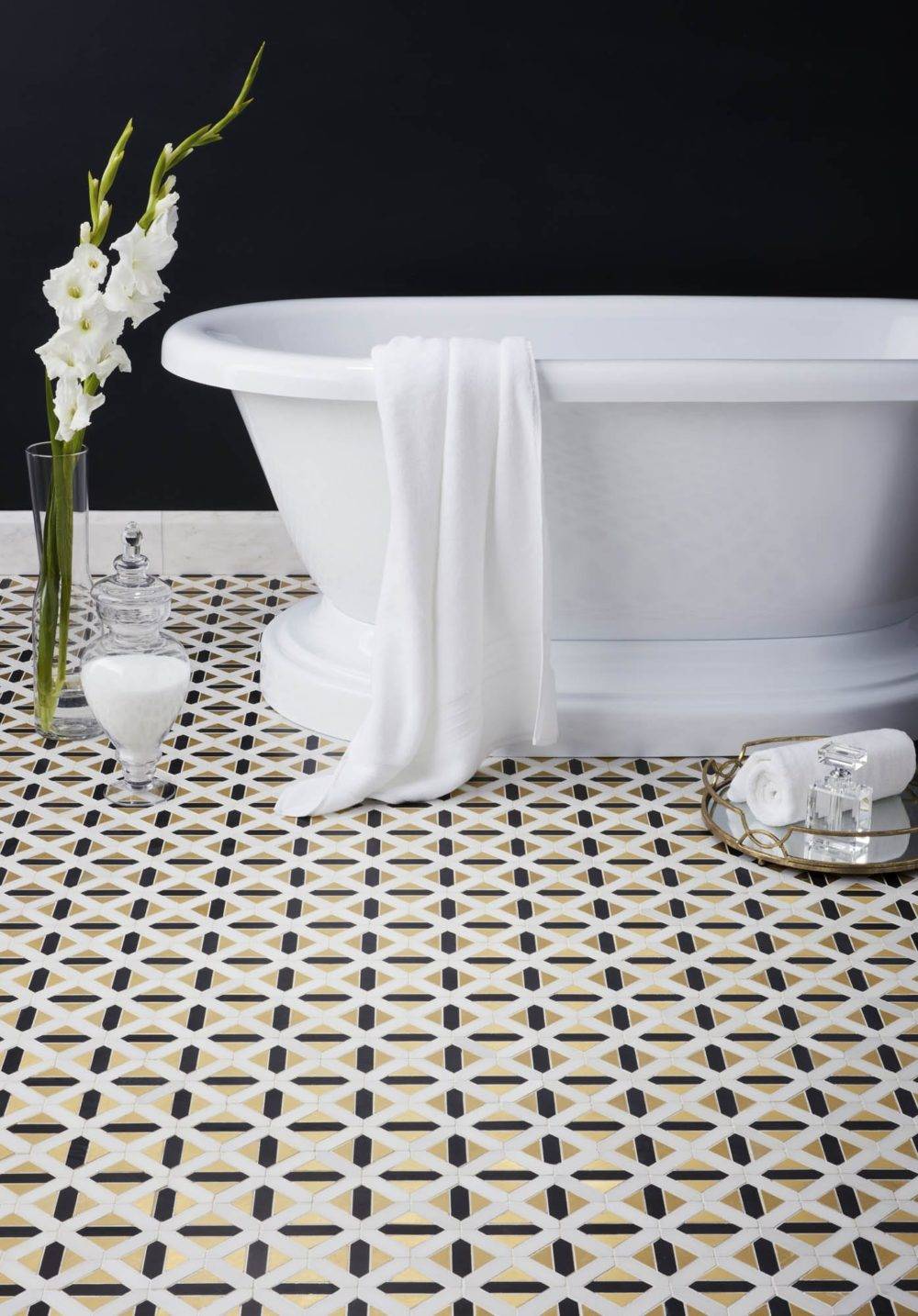
Featured: Corbusier Mosaic
Black and White
Tiling in black and white creates contrast, highlights shapes and lends vintage appeal to a design. Avoid too many bold elements competing in a space with a simple black-and-white base that provides simplicity. A black-and-white mosaic, a bold mix of black and white tiles or an all-over wall or floor in either hue are a few options that create varying degrees of boldness in your look. Black and white get an extra jolt of glamour when they’re in a reflective material or mixed with metal.
Polished Metal
Polished metals, especially gold, are a quintessential feature of Gilded Glamour style and perfect for adding a gilded touch. Incorporate a metallic accent almost anywhere, from tile to shower heads to the vanity. Hints of soft brushed gold peppered throughout the bathroom below tie the whole space together elegantly.

Featured: Tempesta Neve Marble Mosaic, Bulevar White, Tempesta Neve Somerset, Tempesta Neve Barnes, Tempesta Neve Amalfi Mosaic, Bianco Carrara Curb

Featured: Bulevar White
Dural metal profiles are another decadent way to sprinkle bits of metallic shine throughout a tile design. This subtle sparkle elevates the entire space.

Featured: Dural Metal Profiles, Ashford Carrara
Reflection
Not only does it open up a space, reflection adds an element of shine which perfectly complements the luster of Gilded Glamour. Plus, mirrors and reflective elements allow a small or dark room to feel brighter and lighter. As with all the elements of art deco, the extent to which you use mirrors is up to you. A touch of mirrored tile serves as an accent piece while a fully mirrored wall becomes a statement. Take a cue from this design. The mirrored tiles are a bold element so the rest of the design is simple and monochromatic.

Featured: Camilla w/ Mirror, Antique Mirror Bevel

Shine
Polished stone, iridescent finishes, metallic details—shine is an integral part of Gilded Glamour because it serves to add the luster that enhances a space. Polished marbles and other stones define rooms with subtle shine and retain a neutral hue while bright and bold tiles make a more dramatic statement. Pair tiles with shine with other reflective elements sparingly to avoid competing focal points. Below, the crisp white marble is the perfect complement that lets these gold tiles sparkle.
Our Take on Gilded Glamour
Inspired by a modern take on art deco, The Tile Shop’s design manager, Kirsty, envisioned an elegant bathroom with touches of gold and lots of rich marble. Since it’s impossible to create a display with every tile we carry, she used this inspiration to design a visual that would spark ideas for our customers. It turned out so beautifully that, before long, this design dream became a reality.

An artist’s interpretation of our Gilded Glamour bathroom.
This stunning design has everything we love about art deco in a softer, more modern style. The ornamental opulence of Gilded Glamour is visible in the touches of soft brushed gold and the art deco mosaic, which was inspired by a traditional motif. The floating vanity, light fixtures and cool-grey marble modernize the style. The sleek, rounded corners of the mirror mimic the shape of the mosaic and the gold accents coordinate throughout, effectively creating a cohesive look. Layered trims accent the Moderne Deco mosaic on the framed shower wall and in the functional recessed shelf, creating another luxurious detail.
The result is an elegant and soft take on art deco style that feels timeless and modern at the same time.

Featured: Moderne Deco, Verona Blanco, Roman Silver

From an idea to an artist rendering to a real-life installation, the evolution of this idea is dazzling.
Ready to add some modern Gatsby glamour to your space? Schedule a design consultation or stop into your closest store to get inspired and start your project today.
The post Gilded Glamour: How to Tile in Art Deco Style appeared first on The Tile Shop Blog.
]]>The post Why Multifired Tile Is The Next Big Trend appeared first on The Tile Shop Blog.
]]>
Featured: Twenty TD Rose AC 5 and Twenty TD Rose AC
Multifired tile is a technological advancement that has us (and the tile industry) pretty excited lately. These pieces are unlike any others, with metallic details, intricate patterns, dimension and other unique features. We’re going to break down the intricate process required to create them, explain what makes these tiles so special and show you a glimpse at some of the beautiful new multifired products we have in our stores.
What Are Multifired Tiles?
Simply put, multifired tiles are tiles that have been fired in a kiln multiple times. A standard tile is generally fired one or two times while multifired tiles are fired three or more times. But it’s not quite that simple…

Featured: Cub Gold AC. Design by Construction2Style. Photography by Chelsie Lopez Production.
The Multifired Process
This interesting process is actually much more time-consuming and involved than it sounds.
First, raw materials are mixed together and shaped. Once the materials dry, each firing that the tiles go through has to be at a specific temperature. In the manufacturing facility, kilns have a temperature schedule over a month. This means that a batch of tiles has to wait until the kiln is at the exact temperature prescribed for each firing. With three or four total firings at different temperatures and cooling periods in between, it’s easy to see how this draws out the process. This added time and attention required increases the value of the tiles.
After the first firing, which defines the body or bisque of the tile, the second firing establishes the base color. The glazes that are applied before the third or fourth firings are often digitally printed onto the tile into intricate patterns. This type of glaze holds its shape more than others resulting in a 3-D effect. All multifired tiles have some element of dimension and texture due to this glazing process. After a last firing and cooling, the tiles are finally complete works of art. This extended process of cooling, waiting and firing produces a very special porcelain or ceramic tile.

Featured: Dot AC Rose Gold
The Beauty of Multifired Tiles
Now that we know about the process, let’s talk tile. The effects created are much more unique than the process itself. Beautiful pearlescent, iridescent and metallic finishes are possible with three- and four-fire tiles. 3-D effects take tiles to another dimension, adding textures unlike anything you’ve seen before.
In the image below, Stencil Light AC wows with bold, artistic strokes, and the dimension of the tiles adds even more intrigue.

Featured: Stencil Light AC
Designing with Multifired Tiles
Tiles that are this bold and statement making take some thoughtful planning to use in your home. While a stand-out design is the goal, it’s important that your multifired tile also fits into your space.
“A great way to design with multifired tiles is to use them like wallpaper. Tile is so much better than wallpaper because it won’t peel and it can be wiped down, perfect for families with kids and pets,” says Kirsty Froelich, Tile Shop design manager. Installing tile on an accent wall delivers floor-to-ceiling pattern just like a wallpaper would.

Effect is so tactile—you want to reach out and touch it,” says Kirsty Froelich, design manager. Featured: Effect Dark AC
Kirsty has a few additional tips for designing with bold, multifired tiles.
“It’s like a decorative mural. Don’t use other pieces that will make the look too busy. Try complementing a multifired tile with solids that allow it to stand out.”
When creating a wall that features patterned tiles along with solids, don’t forget to make a smooth transition between the two while increasing the designer effect. Layering pieces that feature elements of both tiles tie them together and create a cohesive feeling. We love how layering this stunning DURAL Plus Gold 24K in between two black Somersets brings out the gold tones in Effect Dark AC while finishing the edge. Below is a closer look at how to layer trim pieces that bring out the colors of your tile.

Layering finishing pieces with multifired tile give the look a designer touch and brings out accent colors.
Tile Technology
Tile has been around for a long time. Until recently, the majority of tiles produced have been one or two fire. That makes this new process one of the most exciting in years. The advancements in technology have made designs possible that would never have been imaginable in the past. And we love that it enables us to offer the newest styles and the cutting-edge trends to our customers.
Excited about multifired tiles? So are we! Stop into your closest Tile Shop, and ask to see what’s new in three- and four-fire tiles—and prepare to be wowed.
The post Why Multifired Tile Is The Next Big Trend appeared first on The Tile Shop Blog.
]]>The post How to Achieve Modern Farmhouse Design with Tile appeared first on The Tile Shop Blog.
]]>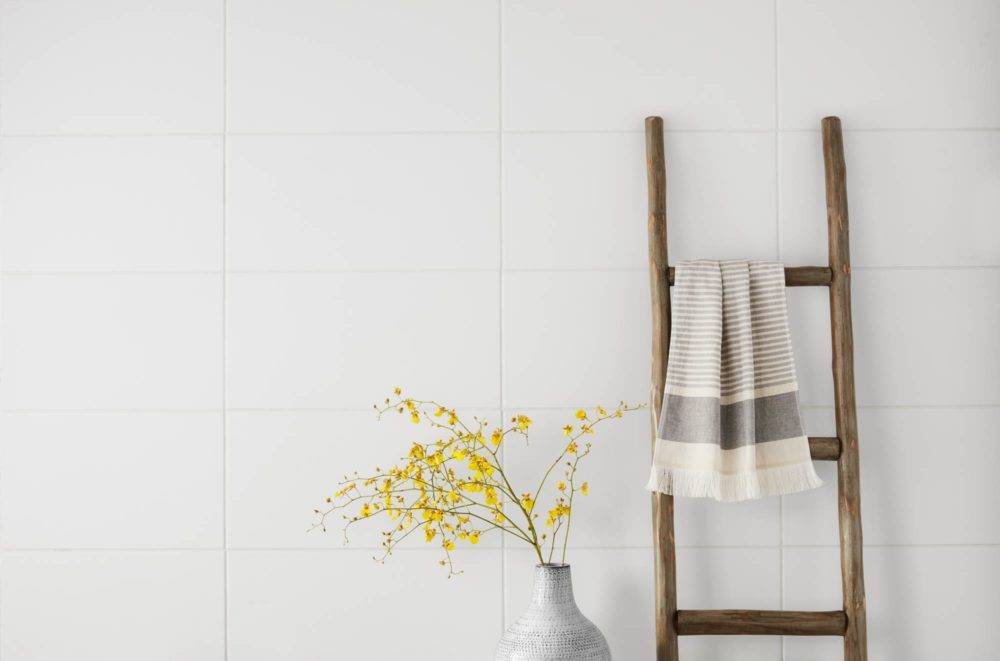
Featured: Textile Graphic White
What Is Modern Farmhouse Style?
Modern farmhouse style is all about warmth, simplicity and function. It’s never fussy, and it always feels lived in. A modern farmhouse interior is one where guests feel at home curling up into a comfortable chair. It’s a beautiful and fresh way to combine tradition with trend. Eclectic-minded individuals will easily embrace the modern farmhouse look because antiques, vintage pieces and new items in a variety of design styles all have their place and can work together seamlessly. In the example below, a modern chair, pillow and rug easily coexist with antiques, traditional wood and classic elements of Americana. The overall look is welcoming, warm and the embodiment of the modern farmhouse trend.
If you think you’ve seen this style before, you probably have. This design aesthetic has gained a lot of traction after being featured prominently on “Fixer Upper” with Chip and Joanna Gaines. It’s also popular because it incorporates aspects of many different styles—modern, country, industrial and rustic, to name a few—which appeals to a wide audience.
Since modern farmhouse style is all about mixing and matching, tiles can easily become an integral design element that incorporate with the other elements in the room seamlessly. Hundreds of tiles embody the modern farmhouse aesthetic, however, we recommend choosing tiles from one (or more) of the following categories that epitomize the style.
Modern Farmhouse Tile: Metallics

Featured: Star, Imperial Pewter Gloss Subway, Brushed Copper Rounds, Etna Concreto Wood Look, Antique Copper Somerset
Modern Farmhouse Tile: Wood and Wood Look
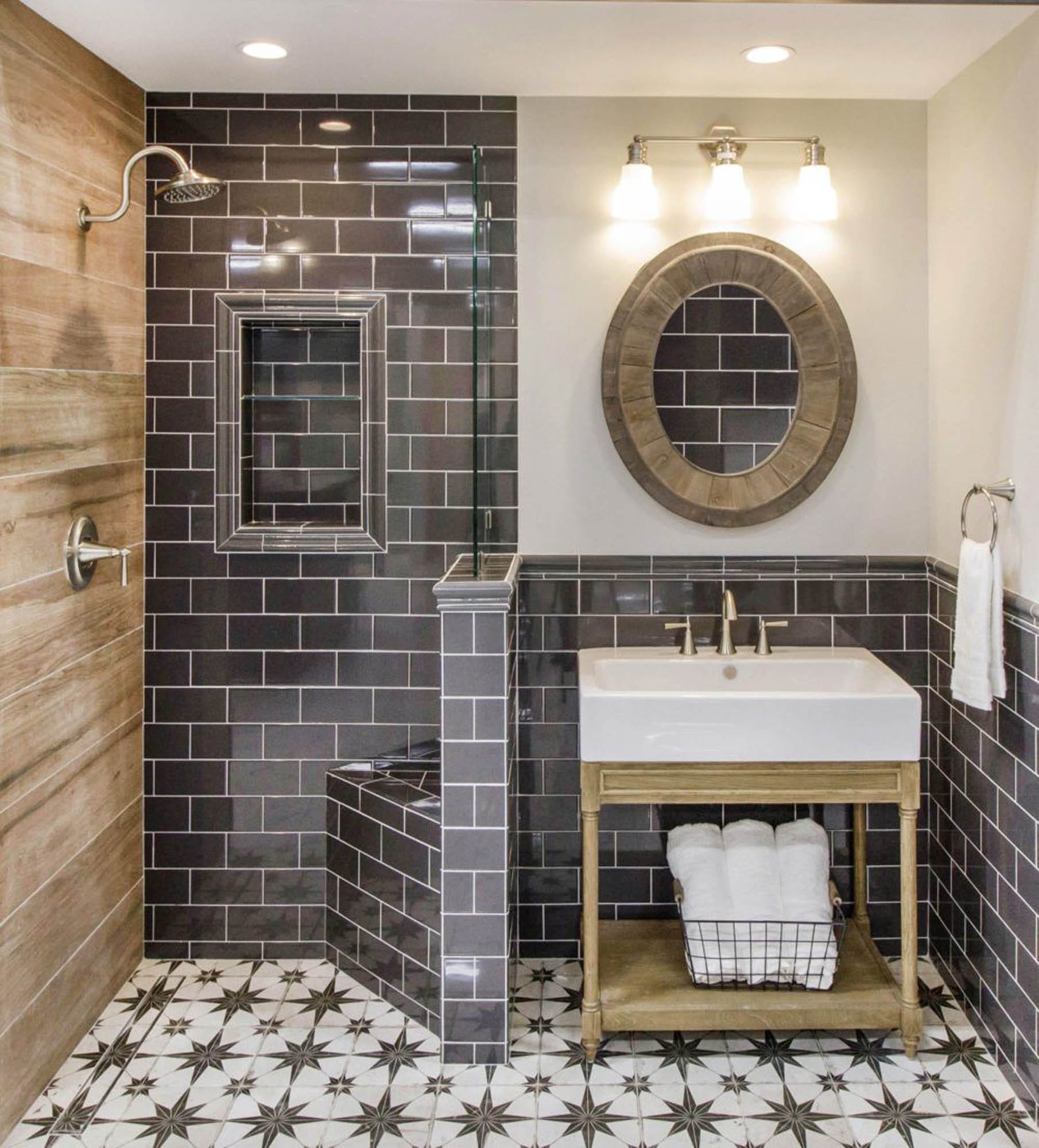
Featured: Cleveland Roble Wood Look, Star, Imperial Pewter Gloss Subway, Imperial Pewter Gloss London
One of our favorite modern farmhouse looks, the bathroom above is a perfect example of warming up a room with wood and wood-look tile. The wood-look tile on the shower wall warms up the entire room and visually ties all of the tiles together as a transitional color between the light and dark shades. The natural wood vanity and mirror complement the shower wall without being a perfect match—another essential ingredient to modern farmhouse design. It’s not about perfectly matching pieces but about coordinating them. Other elements that give this bathroom a modern farmhouse feel are the wire basket, the mixed metallic fixtures, the encaustic-look floor and the apron sink.
Modern Farmhouse Tile: Encaustics and Patterns
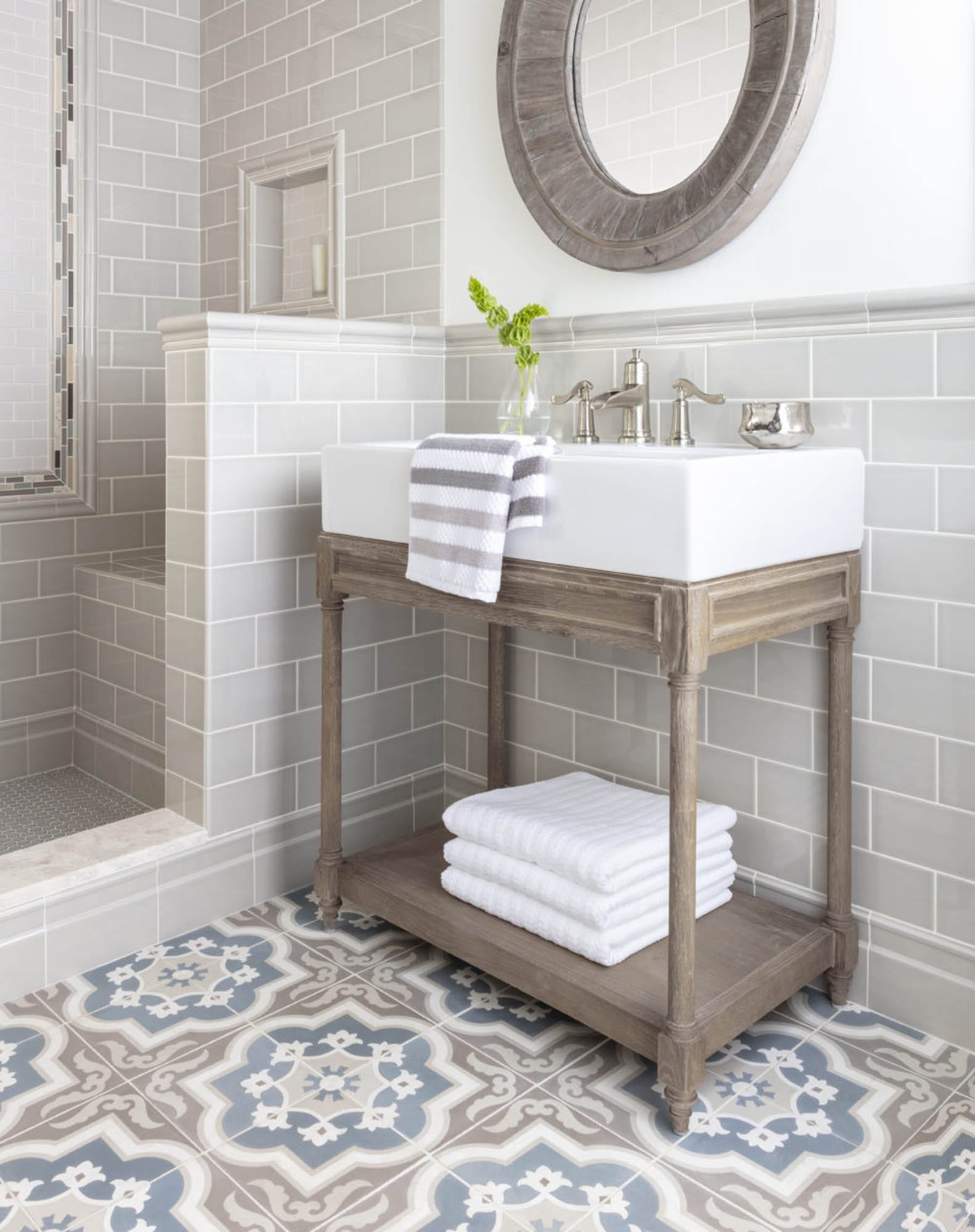
Featured: Villandry Azure, Imperial Oatmeal Gloss, Imperial Oatmeal Gloss London, Amalfi Light Sand Mosaic, Waldron Stria
This isn’t the first time you’re seeing patterned tiles in this post. In fact, almost every featured modern farmhouse design incorporates encaustic or patterned tiles for one simple reason—they’re everything to love about modern farmhouse style. Patterned tiles add a handmade, vintage feeling and colors that warm up a space casually, creating that lived-in, functional feeling essential to a modern farmhouse space.

The encaustic cement tile in the bathroom above adds a classic pattern while incorporating warmth through color. The natural wood of the vanity and mirror coordinate with the floor tile and warm up the traditional subway tiles to complete the look.
Modern Farmhouse Tile: Handmade and Handmade Look

Featured: Star, Hampton Tumbled Niles. Photo courtesy of West Bay Homes.
With the look of a well-worn, vintage piece, it’s no surprise that handmade and handmade-look tiles are perfectly suited to modern farmhouse design. They lend an authentic and traditional feeling to a room that is an essential component to the style. Instead of clashing with clean white cabinets and walls, the Star floor tile in the image above serves to soften and enhance the neutral color palette while introducing a weathered feeling to the room. Other elements of modern farmhouse interior design used here are white painted wood, shiplap walls, a woven basket (a motif also reflected in the basketweave mosaic tile), vintage wooden chairs, mixed metallic fixtures and the functional layout and design of the space. Brick and brick-look tile, as well as most “imperfect”-looking tile, will also work well with this style.
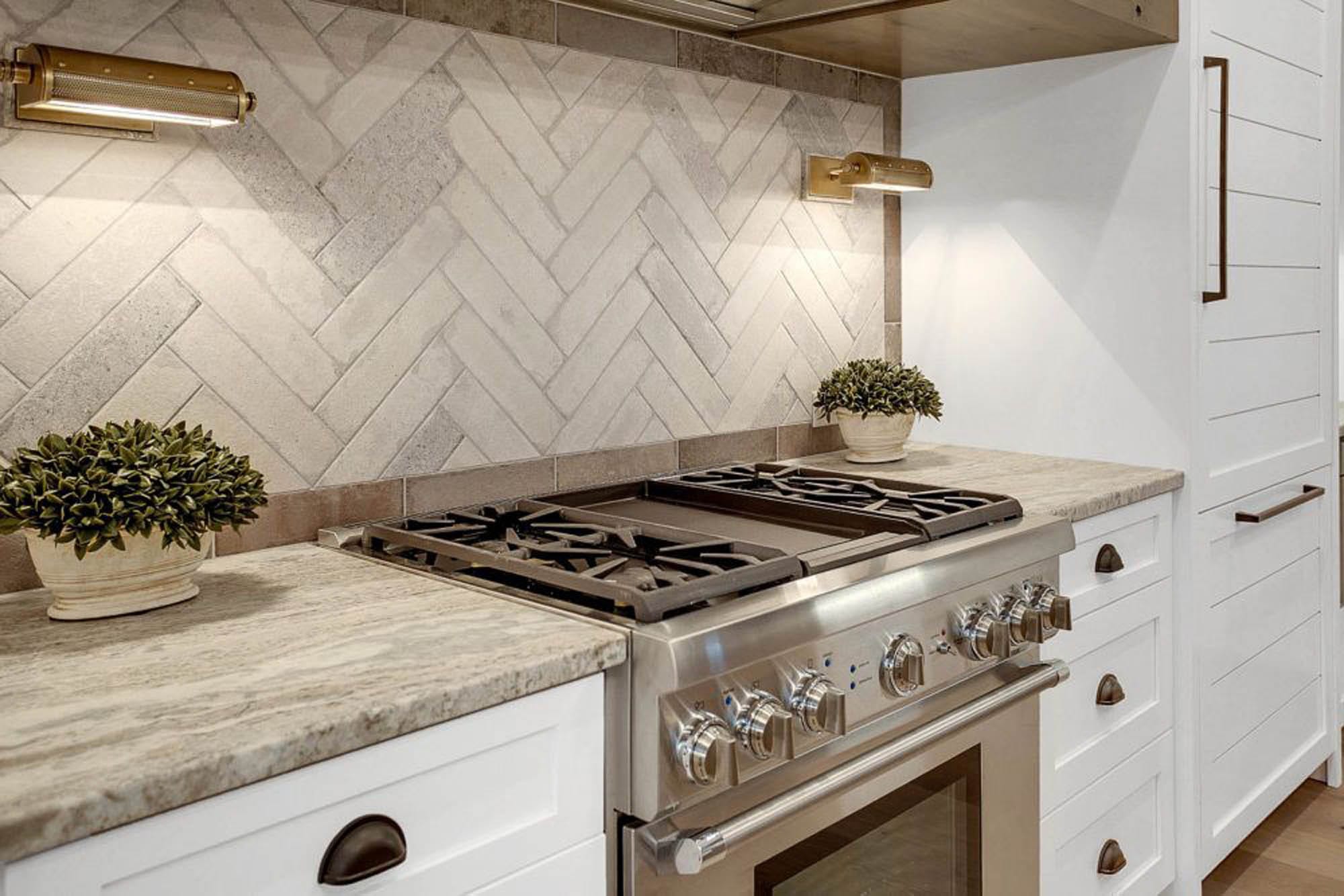
Featured: Bricklane White
If you love this look, see more modern farmhouse style done right by one of our inspiring Pro partners who have perfected this design style, West Bay Homes.
Accessorizing the Modern Farmhouse
The rules of accessorizing in modern farmhouse style are much the same as the rules for tiling. Ask yourself if an item makes the room feel comfortable, inviting and authentic. Painted cabinets, farmhouse or apron sinks, shiplap, barn doors, wire shelves, woven baskets, Shaker-style furniture, industrial lighting, big farm tables and rustic pieces that look like they could have been salvaged from a farmhouse (or, better yet, actually were!) are a great start. As you continue to build upon the essentials to create your modern farmhouse, make sure everything you add is something that you’ll love spending time with every day.
Ready to get started? Schedule a design consultation with us today.

Featured: Decor Basma White Pav
The post How to Achieve Modern Farmhouse Design with Tile appeared first on The Tile Shop Blog.
]]>


Metallic tiles are some of our favorite ways to add punch to a design, especially in a modern farmhouse space. This brushed copper penny round accent in the photo above, enhanced by a frame featuring an antique copper metal trim, adds a pop of color and a rustic element to this room. And don’t be afraid of mixing metallics—copper, silver, gold, stainless and bronze can all live harmoniously together when done right. To avoid metal overload, we recommend using no more than two or three different metals so they aren’t competing for attention. Mix up the textures of your metals, and complement warm or cool color palettes with warm or cool metals, respectively. When in doubt, less is more.
Completing this wet bar in true modern farmhouse style are an encaustic-look floor, an open, wood shelf, a natural, woven basket, a painted cabinet and wood-look walls—a true mixing and matching of styles.